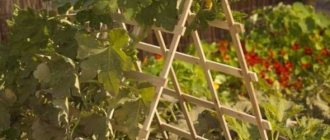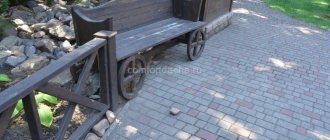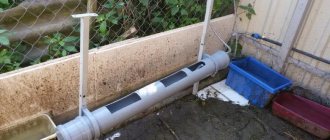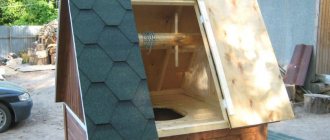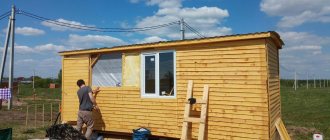If you need benches for your dacha, then the best option would be cast iron benches, which can always be found and purchased on the website https://maftop.ru/chugunnye-skameyki/.
It's nice to enjoy the environment while sitting on a bench. Such a familiar object to many can be significantly transformed. The design is played out using simple methods that you can actually do yourself.
Original benches made of wood
If you consider yourself a creative person, by looking at the photos of benches for your garden, you will definitely find the option you need.
With an abundance of greenery and large flower beds, you can use a little trick. It is necessary to unite the flower beds with a board. By placing several long boards on the wall (with the bench positioned near the wall), you will create a backrest.
To make your own, you should select ready-made flower beds and purchase a sanded board. An alternative option is half a log.
Using a metal corner you can secure the seat. Use self-tapping screws and bolts for secure fastening to wood. Dowels are suitable for fastening to concrete.
Materials for making benches
Current technologies make it possible to make benches from both classic materials such as wood, wrought iron, stone slabs, marble, and ultra-modern ones - plastic and synthetic fiber. Often the material for the production of benches is combined from 2 or more components. Taking into account the general stylistic direction, it is necessary to select the material for the manufacture of the future bench with special care. For example, wood goes well with glass, and forged steel will look good with both wood and stone. Such a combination of materials will be an excellent decoration for a garden designed in a classic style. But a plastic bench will be the final decorative element for a modern-style country house.
Unusual bench design
Of course, the most popular material for making benches is wood. Natural material always looks fashionable, beautiful, and elegant. Its main advantage is that it is absolutely not harmful to the owners of the site and to the environment as a whole. For many to this day, the harmlessness of the materials used is the main criterion when choosing any product.
Teak is mainly used to make benches. Considering that the benches will have to stand in an open space under the influence of natural factors, the material must be as moisture resistant as possible. It is teak wood that has been famous for this since the days of ship construction.
Bench by the pond on the site
Of course, any material is not eternal, including teak, but if you take care of it in a timely manner, wipe off the gray coating that appears from interaction with fresh air, sun, rain, it will serve you for many years, delighting you not only with its beauty, but also also for its versatility and reliability.
In addition to benches, garden furniture manufacturers can offer you a whole range of related decorative elements for decorating your garden plot, such as a table and chairs, as well as swings and even chests for storing all kinds of utensils. A whole ensemble of garden furniture, made in the same style, will be an excellent decoration for any garden.
Cozy wooden bench
Logs
A DIY garden bench made from logs can highlight the ethnic, rustic style. This design consists of a trunk sawn along.
The backrest is a polished trunk, the legs are made from narrow pieces of logs. All elements are connected into a single whole using metal pins.
How to make a bench: photo reports
We won’t make benches out of stone—not everyone has the equipment, but we can make them out of different pieces of wood. Let's talk about making simple but unusual designs. So that a handmade bench can be a source of pride.
Bench without back
The design is simple, but looks interesting due to the specific material. For the legs, timber with rounded edges was used. If you have small logs, you can trim them on the sides. You'll get almost the same effect. THIS material is not so rare; the legs are assembled from it in an unusual way: the bars are laid flat on top of each other. This adds zest and appeal.
A simple bench looks interesting due to the material
This bench without a back has a length of about 120 cm, a width of about 45 cm, and a height of 38 cm. You can round the edges of the beam using a cutter, or you can find a similar profiled one. It costs more, but it will be easier to work with: it is already well processed and is easy to connect.
Depending on the found cross-section of the timber, calculate the length you will need. Determine how many bars will have to be stacked on top of each other to achieve the required height. In this case, 5 bars were used for one leg. Total 45 cm * 5 pieces - 2.25 m. Two legs required 4.5 m of timber. A board 40 mm thick and 90 mm wide was used on the seat. For the seat you need 5 boards 1.5 meters long. It turned out 1.2 m * 5 pieces = 6 m.
First we cut and process the boards for the seat. Their edges must be rounded. If you don’t have a sanding machine or a router, you will have to work with sandpaper, but you can find such a board or arrange at a sawmill to have it processed and sanded for you: it will be much less work. So, we cut the boards to the same length, sand them and varnish them (with or without tinting - your choice).
Treated boards
Place the bars for the legs one next to the other, aligning their edges. Using a square and a pencil, draw lines where the fasteners will be placed. The distance between the lines is 7-10 cm.
Lines where the pins will be installed
You can take metal pins, or you can make dowels - carved from wood. Holes slightly smaller in diameter are drilled for them; the depth of the hole is half the length of the pin. Then they are hammered into one part, and a second part is inserted into the same hole on top. The connection is reliable, but to be sure, you can add glue, although then the structure will turn out to be one-piece.
With a pin connection, the main task is to make the holes strictly one above the other so that the parts mounted on the pin give a smooth edge. We've done part of the work - we've drawn lines where we'll drill, now we need to measure the same distance from the edge. For this we will create a template. We take a piece of plank about 1.5 cm wide. We will drill holes at this distance from the edge of the bars. Having placed it exactly along the edge, we mark the places of intersection with the drawn perpendicular lines.
We make holes in the bars in a checkerboard pattern
We will install the pins in a checkerboard pattern, so we will drill holes through one intersection. We also make holes on one block from different sides in a checkerboard pattern. In a similar way, using pins, the legs are connected to the seat: two pins for each plank.
Technologically, this type of connection is correct, but it is complex and requires a certain skill. It could be easier. Place all the bars one on top of the other, secure with clamps, drill through in two or three sets - in the center and along the edges, connect with a long pin, with washers placed under the head and nut. You can nail the seat strip legs to the legs assembled in this way with nails from above or try to make a pin connection.
The bench is made by hand. Finishing work remains
If you nailed the seat, take some wood mastic of a suitable color, add some very fine sawdust and stir. Apply this mixture to the joints. When dry, smooth it with sandpaper. Sand all parts smooth and coat with varnish or wood paints for exterior use (preferably not covering ones, but those that leave the wood texture visible).
How and with what you can paint wood, read this article. It talks about lining, but the painting techniques remain the same, and the compositions must be taken for external use.
DIY bench made from broken chairs
In any household you can find two old chairs. They should be the same and still strong enough. We disassemble the chairs, leaving the part with the back and legs. We connect the two backs using bars of a suitable cross-section.
Bench made from old chairs
For greater rigidity at the bottom, at a distance of about 20 cm from the floor, where previously the chairs also had jumpers, we make another frame with transverse crossbars. It can be used as a footstool or to store some things.
We paint the completed structure
After sanding, we paint the resulting structure. This time the paint should be ordinary: different types of wood can only be painted over with covering paints. Apply with a brush or from a spray can.
All that's left to do is cut the seat to size from thick plywood (8-10 mm thick) and cover it with foam rubber and fabric.
Finished bench made from strusses
Garden chair/bench made from pallets
Everything is useful on the farm. Even cargo pallets can be used to make garden furniture. Moreover, there is no need to disassemble them: we use one for a seat, and from the second we will make a backrest. You will only need well-processed planks for the armrests and bars for the legs.
This is what should happen
In one of the pallets we strengthen the fastening points by inserting pieces of bars. Having inserted it, we fasten it with self-tapping screws on one side and the other.
Strengthening the corners of the pallet
From a timber with a cross-section of at least 100*100 mm, we cut four identical sections 80 cm long. We screw them in those places that we have just reinforced. We leave 20-25 cm on the legs. We fasten with four long screws - 150 mm and no shorter.
Screwing the legs-supports for the armrests
It is important to maintain verticality and leave the same distance on the legs. Then the seat will be level. If there are errors in height, you can try to file it down, but then you will have to cut it from the top too - so that the armrests are even. So try to screw it straight. Deviations from the vertical can only be dealt with by screwing the leg back on.
The legs are screwed
We attach a second pallet to the rear posts, and boards for armrests on the sides.
Almost done
All that remains is to cut a piece of furniture foam rubber and cover it with fabric. You can also make pillows for the back. If you are not going to process everything thoroughly, but make a loft-style chair, use sandpaper or a sander, sanding all surfaces until smooth. You can coat it with paint, giving the wood a dark color.
Finished product: pallet chair
Set
A fairly thick board serves as a seat; the legs are made from most of the deck. Initially, a space intended for a seat is cut out in the deck.
The ideal option is a “wooden set”, when a table and a bench are made from wood at the same time. You will need working materials: logs (for the lower part of the product, legs), sanded boards (for the upper part).
Useful ideas
It is not necessary to spend a lot of money on bars and boards when making a bench from scratch.
We recommend reading:
Beautiful houses for a well - 115 photos of design ideas and examples of well design- How to make a hammock for a summer house: ideas and tips on how to make a simple and beautiful hammock with your own hands (120 photos and videos)
- Making a mailbox with your own hands: tips and step-by-step descriptions of how and what to make a mailbox from (95 photos)
There are a lot of useful wooden products around that are worthy of acting as legs or load-bearing elements:
- Logs;
- Old chairs;
- Table tops;
- Worn doors;
- Fencing.
With a chainsaw, you can saw logs to create massive legs. And if the stationary model does not suit you, then a bench with a back and chair legs will serve as an excellent alternative.
Family Corner
A simple solution would be to build a wooden bench for the dacha around a tree. The design is not at all complicated; even a novice master can handle the flooring.
To create a cozy, warm atmosphere, just add bright pillows and decorate such a bench with flowerpots. Often this corner is supplemented with a swing and a wooden gazebo.
Pergola
An alternative to a gazebo is a “pergola” made in the form of an arch. It is decorated with an abundance of greenery and fresh flowers, and grapevines are planted.
On the opposite side of such a garden bench you can put a small fountain in your dacha. This design will complement the appearance and form the integrity of the picture.
Territorial placement of benches
Placing benches on a private property site implies an appropriate arrangement of recreation and relaxation areas. Places where the whole family can relax together give landscape design a unique image and style. That is why it is so important to correctly place benches around the site, taking into account its relief and landscape, and choose the appropriate design for them.
Arrangement of benches in small dachas
If you plan to install single benches, then do not forget to place one bench at the porch; if there is none, then at the entrance to the house - this will be an excellent sign of hospitality. For owners of a small plot, it will be enough to place another bench somewhere in the depths of the garden under a leaning tree in the shade, away from the noise and bustle, from hassle and worries. This place can become a paradise for all family members to relax in peace and solitude.
Wooden bench in a small area
Compact bench with arch
Placing benches on the site of a large country house
On a large area, benches are placed along garden paths; if there is a fountain or/and a pool, then near them. It will not be difficult to place the bench on the lawn, just keep in mind that the lawn grass may be damaged. If the owner of the house knows in advance where the benches will be located, it is better to plant grass that is resistant to trampling. Benches near pergolas, arches and hedges of green plants, which attract vacationers, would look appropriate. It wouldn’t hurt to put a couple of benches near the garden, or at least one for relaxing after physical labor.
Bench and other garden furniture on a large plot
Terrace with bench and other furniture
Ideas
The bench, the seat of which is attached to a voluminous stone, looks original.
Bamboo trunks can be used as the main material for making a bench. This product looks truly impressive.
Additional materials for the bench
If we talk about the full production of a bench, then you won’t be limited to just metal and wood. There is also a small list of materials and consumables that will be needed. They are listed in the following table.
| Materials, photos: | Description: |
| Primer paint for metal | The final coating of the metal may vary. Primer enamels are often used, which do not require surface preparation, apart from cleaning it. This paint is applied in several layers. You can even cover rusty areas with it, but we do not recommend doing this, since the service life of the protective layer will be reduced. |
Grinder circle for cutting metal | For frame structures, the metal always has to be cut to the design dimensions. For cutting, abrasive wheels are used, mounted on a grinder or similar tools. Wheels made of the same material are used for grinding metal and processing welds. |
Wire brush | Before painting, the metal must be cleaned. The task is to remove all the rust and expose its shiny surface. On this basis, even primer paint will adhere much better. |
| Degreaser | Before painting, the metal is degreased. This will seriously increase the adhesion of the material and promote even application of paint layers. As a degreaser, you can use universal compounds, which are ordinary kerosene, or its light varieties, for example, white spirit. |
Electrodes for welding | Electrodes are also consumables. Without them, the benches definitely cannot be assembled. |
| Set of metal drills | You will need to drill a little, but you should always have several drills of the required diameter in stock. Holes are made for bolted and screw connections. The wooden part of the bench is fastened in this manner. |
| Bolts and screws | Again, necessary to secure the wooden parts of the frame. Sometimes they are used to connect metal parts, although welding is the preferred method. |
Wood processing materials | We have combined them into one line because different options may apply. Let us note antiseptic impregnations, which significantly increase the service life of wood in the open air, impregnations for changing the color of boards (this includes oils, stains, glazes, waxes, etc.), protective compounds and paintwork materials that create a waterproof film on the surface. These properties may be combined in some materials. For example, oil from water qualitatively protects and transforms the color of wood, making it more saturated. |
Sandpaper for random orbital sander | The surface of the wood must be carefully treated to make it smooth, safe and pleasant to the touch. To do this, it is polished with abrasives of different fractions. |
This variety is accompanied by the following set of tools:
- Bulgarian.
- Carpenter's square.
- Electric drill.
- Sander.
- A hammer for knocking down scale after welding, and indeed this tool is always required.
- Clamps for preliminary fixation of parts.
- Brushes or a small roller for a more even application of paint.
- Welding machine.
- Tape measure, pencil, marker.
- To create curved parts, a pipe bending machine is required
Pipe bending machine Other
small things can also come in handy, which you will find out for yourself when you start assembling your bench.
Economical
Wood is considered the most cost-effective material. Therefore, from such material you can independently make an inexpensive bench for your garden. It is important to use small beams with rounded edges. The material should be trimmed first.
News site- Features of electrical wiring installation in houses made of SIP panels
- How to choose a cast iron bath
The bars must be laid one on top of the other; a long, wide wooden board acts as a seat. The material must be polished. Such a product will delight not only you with its attractive appearance.
Bench for the garden or choosing material that will last forever
A good garden bench means convenience, long service life and beauty. Manufacturers offer to choose a piece of furniture from natural and innovative materials; hand made craftsmen are able to create it according to a drawing from anything. It is worth studying the positive sides and negative qualities of each and making a choice.
Wood can be in the form of beams, logs, branches, boards.
A wooden bench in the garden can be considered a classic of the genre.
Wood (larch, pine, spruce):
- environmentally and biologically friendly;
- durable, as it is impregnated with a special antiseptic and is opened with several layers of varnish;
- ideal for Provence, country or similar style.
Most often they make a set: a table and benches for it, located opposite each other.
Negative aspects include drying out (over time) and a narrow range of forms.
Attention! If you want to buy a bench for a long time, you should not save. The best solution is wood, which serves for a long time and reliably.
A metal garden bench has the following advantages:
- strength and reliability;
- durability of use;
- resistance to adverse weather conditions.
Benches for summer cottages made of metal are durable, reliable, resistant to any precipitation and mechanical damage.
The “disadvantages” include heavy weight and monumentality. The latter quality “weights down” the garden space, so it is better to choose benches with forged elements or made in the form of a grid, etc.
To decorate the yard, they are made with various curls, patterns, colors that create beauty and original design.
A modern garden bench made of plastic is:
- a light weight;
- anti-vandal qualities;
- low maintenance requirements;
- long service life;
- significant strength.
The plastic bench is lightweight and easy to transport.
The negative aspects include fragility if a low-quality piece of furniture is chosen.
A stone bench installed in the garden will make an interesting impression. Natural material will appeal to you for the following reasons:
- sophistication and rich color palette;
- increased strength;
- long service life.
If manufactured correctly, such a bench can be quite durable, reliable and will decorate your garden.
The only drawback is the significant cost, since such benches are made of granite or marble.
Simplicity and convenience
The preparatory stage is present in all processes. The procedure for making a bench will not be an exception. First you need to prepare drawings of a bench for a summer house, indicating the optimal dimensions. The product without a back has a length of 120 cm, a height of 38 cm and a width of 45 cm.
To smooth the edges of the timber, use cutters. This simplifies the work process, despite the high cost.
The length depends on the cross-section of the beam you choose, then the height of the leg is calculated.
Design features
Before making complex designs, it makes sense to consider the drawings of an ordinary bench. It can be presented as:
- Standard model with two to four legs and a seat;
- Improved model with legs, seat and back;
- A more unique model, which is complemented by armrests.
We recommend reading:
- What you need for a comfortable holiday in the country.
Alpine slides in landscape design on a small plot: the best ideas and stages of implementation
How to make a country washbasin: examples of building a simple and convenient washbasin with your own hands (90 photos)
When making the back, it is important to adhere to an angle of 105-120° so that you can lean on the product comfortably. If the design has armrests, then let the latter be round or trimmed with wood.
Metal
This material attracts with such quality characteristics as durability, practicality, simplicity and resistance to the external environment.
You can make the product entirely from metal, or combine it with wood. The last option is used most often. A design with interesting openwork patterns will highlight the beauty of your garden.
A mandatory attribute of a suburban area is a bench. In addition to fulfilling its functional task, it can decorate the appearance of the garden and area in general.
There are no financial costs required for this; most of the proposed ideas can be implemented independently.
It is important to choose the option that is closest to you and at the same time will not stand out from the overall stylistic picture.
Clinker brick- Barrel sauna and its features
Apartment renovation
Physiological and psychological aspect
First of all, a bench is a functional design, which will require special attention when choosing its size. For example, if a bench is installed in a recreation area for the entire family, then its dimensions should be appropriate. For those who do not like long and bulky structures, several small, neat benches are also suitable, the main thing is that all household members and their guests can comfortably accommodate. But in pursuit of beauty, do not forget that the structure must also be convenient, comfortable for sitting and conducive to a pleasant rest or pastime, and in no case the other way around.
Beautiful set of wooden garden furniture
But besides the functionality of the design, there is also a psychological aspect of its use. Psychologists say that sitting together on a bench between spouses, lovers or just friends can reconcile them if they have had a serious quarrel. And people who do not yet know each other can strike up friendships.
Light bench made of wood Dark bench made of wood and metal
Elegant bench made of wood and metal
Photos of benches for a summer residence
Garden bench - a simple version of the folding model
To make a folding bench, it is enough to have solid sheets of wood, a circular saw, furniture ties, a screwdriver, a jigsaw or hand saw, a grinder, a drill or screwdriver, and screws.
As for the production cycle, it is as follows:
- First, you need to get 4 slats 300x40x20, 4 slats 200x40x20 mm and several short slats from a solid mass (2 for drawers, 4 for seat);
- Next, drill holes along the edge of all the slats so that the latter, when joining the first, are at the same level relative to each other;
- Then you need to drill holes at the same level in the middle of the long slats;
- The next stage is joining, in which each pair of short slats is attached to both sides of each pair of long slats, so that the folding of the group is cross-shaped;
- Next, the slats of each group must be connected using furniture ties;
- The groups are connected to each other using a small wooden plank (the plank is attached to long slats);
- The groups are connected to each other by means of a second short strip (the strip is already attached to the short slats);
- Each connecting strip is complemented by a second one;
- The legs of the bench are complemented by drawers that will serve as carrying handles.
Metal benches and benches made of tubes or plates are also a welcome option.
But to work with them you will have to connect a powerful drill (if the walls are thick). It will also help make holes for bolts and nuts instead of self-tapping screws.
Wicker bench
You can also use rods to create a bench. By intertwining them with each other and the frame in the simplest way, you can get such an original place to relax. Making such a bench is not difficult, you just need to be patient. But it will fit perfectly into the look of any garden and will look perfect both on the veranda and under the canopy of bushes and trees.
GO TO THE GARDEN FURNITURE CATALOG!
Many models in stock.
What is a garden without a garden bench! Sitting on it, you can relax from a hard day's work, hide from the scorching heat in the shade, and even stretch out and lie down. In addition, it will allow you to gather in a close circle with acquaintances and friends.
In a word, there definitely won’t be an extra bench, and it’s better if there is more than one in the garden, since it should have recreation areas, because gardens are intended for relaxation.
Don’t forget: benches are an important element of country design that skillful owners use successfully
We offer customers not only beautiful options, but also durable ones, since they are based on granite - a durable, natural material that is resistant to any bad weather.
The benches we offer are permanently installed.
The types of benches presented are replete with variety and each of them has its own advantages.
Plywood bench
Typically, garden benches are made from boards. What if we made it from plywood? Look what amazing designs you can create from this material! Simply cut out parts of a certain shape from sheets and connect them into a single frame. And you can find a great many such examples on the Internet! True, we should not forget that to create such a bench it is better to use only a moisture-resistant type of plywood and be sure to cover it with protective compounds, otherwise the bench will quickly lose its appearance.

